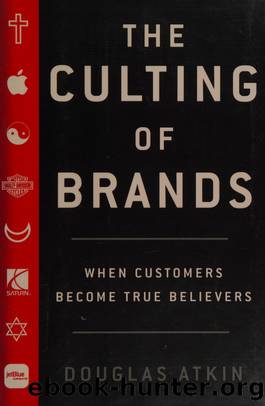The culting of brands : when customers become true believers by Atkin Douglas

Author:Atkin, Douglas
Language: eng
Format: epub
Tags: Merken, Loyaliteit, Customer loyalty, Branding (Marketing), Produits de marque -- Commercialisation, Identity (Psychology), Identité (Psychologie), Consommateurs -- Fidélité, Consumentengedrag
ISBN: 1591840279
Publisher: New York : Portfolio
Published: 2004-08-15T00:00:00+00:00
SYMBOLISM
B rands are symbols. We live in a world dominated by commercial icons, total design initiatives, and completely integrated marketing efforts, where products are consumed less for what they are (materially) and more for what they represent (spiritually, or at least socially). We operate in a symbolic economy. Itâs one where crass products and their meaningless material benefits can be transformed into living vessels of meaning.
What are symbols and why are they so important? Symbols literally make meaning possible; they allow a given worldview to come alive in any and in every community. Symbols are the very stuff of culture, whether they are written, verbal, aural, or pictorial. They are the diverse media by which humans actively and outwardly communicate, celebrate, and protect their beliefs and values. Communities make meaning through public, symbolic expression: They sing it. Dance it. Burn it. Eat it. Wear it. Tattoo it on their face, and shave on their heads. âThe unity of a group, like all its cultural values, must find symbolic expression,â writes sociologist R. M. Maclver,âthe symbol is at once a... means of communication and a common ground of understanding. All communication whether
through language or other means, makes use of symbols. Society could scarcely exist without them.â 1
Symbols arenât just simple one-off iconsâthe cross, the star, the big-bellied Buddha. Theyâre more like a network of signs that tie together an entire set of meaning. Clothes can be symbolic, so can music, food, and behaviors. Historically, these symbolic systems have been generated by cults and religions. From the first human societies onward, cults actively and consciously created distinct cultures through the orchestrated and integrated use of symbolic codes.
Beliefs are well and good in theoryâscriptural truths, mission statements, enduring values and beliefs. In the end, however, ideas fade and only action remains. We are what we do, not what we think. For example, for Hare Krishnas, abstaining from alcohol and drugs, gambling, illicit sexual behaviors, and the eating of meat, fish, or eggs arenât just pie-in-the-sky moral dictates from a fivethousand-year-old God. Theyâre symbolic behaviors, lived day in and day out by over tens of thousands of Krishna devotees worldwide. Chanting, singing, dressing, bathing, shaving, everything a Krishna does and says, everything he touches, wears, eats, or looks at is strictly designed to remind and inspire the devoteeâs loyalty to Krishna-consciousness. Those who fully buy into the Krishna way become totally saturated with symbols of the choice theyâve made.
Up until the 1960s, cults like the Hare Krishnas and established religions like Catholicism provided the lionâs share of symbols and cultures for communities around the world. The fact that brands, and specifically cult-brands supply symbolic meaning to a vast majority of todayâs global citizens is a relatively late, although extremely important, historical development. Over the last hundred or so years, brands more or less functioned as they did from their inception. Marks of authenticity for services and goods. Trademarks for corporate property. Certainly not as symbolic systems for culture. What happened? Itâs important to answer
Download
This site does not store any files on its server. We only index and link to content provided by other sites. Please contact the content providers to delete copyright contents if any and email us, we'll remove relevant links or contents immediately.
Influence: The Psychology of Persuasion by Robert B. Cialdini(4603)
The Miracle Morning by Hal Elrod(4424)
The Hacking of the American Mind by Robert H. Lustig(4090)
Pre-Suasion: A Revolutionary Way to Influence and Persuade by Robert Cialdini(3978)
Unlabel: Selling You Without Selling Out by Marc Ecko(3473)
Ogilvy on Advertising by David Ogilvy(3338)
Hidden Persuasion: 33 psychological influence techniques in advertising by Marc Andrews & Matthijs van Leeuwen & Rick van Baaren(3293)
Purple Cow by Seth Godin(3073)
Who Can You Trust? by Rachel Botsman(3030)
Kick Ass in College: Highest Rated "How to Study in College" Book | 77 Ninja Study Skills Tips and Career Strategies | Motivational for College Students: A Guerrilla Guide to College Success by Fox Gunnar(2998)
This Is Marketing by Seth Godin(2907)
I Live in the Future & Here's How It Works by Nick Bilton(2845)
The Marketing Plan Handbook: Develop Big-Picture Marketing Plans for Pennies on the Dollar by Robert W. Bly(2798)
The Power of Broke by Daymond John(2779)
Building a StoryBrand by Donald Miller(2757)
The 46 Rules of Genius: An Innovator's Guide to Creativity (Voices That Matter) by Marty Neumeier(2678)
Draw to Win: A Crash Course on How to Lead, Sell, and Innovate With Your Visual Mind by Dan Roam(2640)
The Tipping Point by Malcolm Gladwell(2562)
Market Wizards by Jack D. Schwager(2542)
